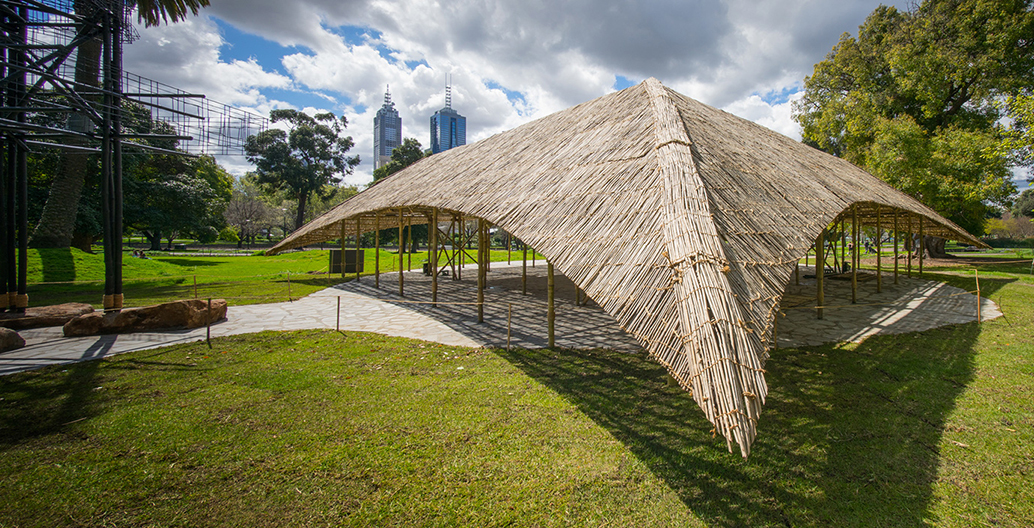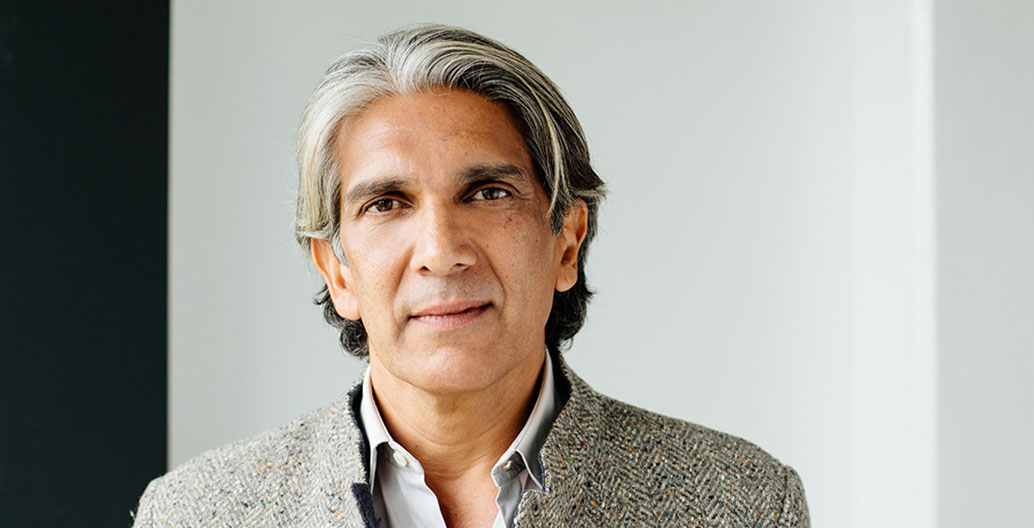
“Designing for me is a constant negotiation”: Studio Mumbai’s Bijoy Jain
Bijoy Jain finds that to raise a building, sometimes its best to use a village. Foreground caught up with the India-based architect for the recent opening of his MPavilion in Melbourne’s Victoria Gardens.
FG: It has been over twenty years since you established Studio Mumbai, at a time in the mid-Nineties when architecture’s romance with ‘the digital’ really kicked in. Yet you deliberately designed a practice that promoted the handmade and traditional building skills. What made you decide on a route that ran contrary to the mood at that time?
BJ: I had been studying overseas, and when I returned to India I quickly discovered that the way of working and building my designs was not as I had imagined. I couldn’t do the work I wanted to, mainly because the construction industry didn’t allow it. So I had to pretty much cobble together a group of people that slowly then grew into a community of skilled people. In many ways I built my studio as a commitment to a particular way of working. It became easier to negotiate outcomes when I was in the middle, making of the building. I invented a model that turned the workshop into a lab, or place of R&D.
There is something in this to do with ownership. Not in terms of property or material ownership, but in the sense of the commitment one makes, or a responsibility that one assumes. You make a commitment to what is being made, and that becomes a sort of exchange that has a certain sense of gravity. This is different from a conventional project, where you make drawings, there is a contractor, there are signed agreements, and everyone is protected. For me it’s important to leave your comfort zone and take risks. But to do that, you have to be completely immersed in the project.
FG: Craft is something that we associate with India. This is distinct from many other countries, where industrial production has diminished the role of making and the perception of the handmade. As an architect based in India, are there challenges in translating your working methods beyond India?
BJ: Honestly, what I’ve discovered is that you can find skilled people everywhere. In fact, I have a regular collaborator who is a Swiss master mason, whose knowledge of lime is unparalleled. Lime is an amazing material because it goes beyond material. It’s almost an atmosphere, because lime has a constant reaction to atmosphere, to air and to water. And that sensibility of working with lime is a very special thing. Or another example, I recently met a metalsmith, and the things that he can make are on a par with a master metalsmith from, say, the period of Versailles.
I’m discovering that there are people like this everywhere. And while, sure there is a financial and economic side to craft and making, it also goes beyond that. The pleasure of a collaboration, within a collective that gets it, has its own rewards. I have discovered there are different trades, different skills and different kinds of people, who are very much in that medium, of thinking and of making. Slowly you build up networks and you start to realise that it’s a sort of growing field. That’s what I’ve discovered through this process – that skilled people exist everywhere.
I like to surround myself in a working environment that’s constructive. One that enables ideas and thoughts to go further than my own potential, which also means not being too predetermined and prejudiced about the final outcome. I see my role is more like a conductor of an orchestra. It’s about how to facilitate.
Designing for me is a constant negotiation, firstly, with yourself, and then as you participate with others, to bring an inclusiveness that draws others into a conversation. I like to create space for others to practice their set of skills, providing of course that you believe that’s the band you want to play some free jazz with.

Bijoy Jain of Studio Mumbai. Image Timothy Burgess
FG: Working with space and working with materials are quite different. One person might know how to make the perfect dovetail joint, while the other knows how to conceive of a perfect space. They are related but distinct skills. How do those two bodies of knowledge and skill interface in your studio?
BJ: What I bring is an understanding of space, and I can use that quite broadly. Then, when translating that skill into something more specific, like a dovetail joint, as you say, my role is to form a bridge or conduit between the spatiality of a project, and these very particular tasks or situations, the minutiae you might say.
Working like this means I don’t collect product catalogs. Zero. I won’t say we start from scratch, but there is a materiality that exists and, just through conversation, through storytelling or through ideas, the work emerges. So all the projects are very particular in themselves, in the sense that nothing is pre-determined or predefined by an industrial catalog or process. Part of this way of working, for me, is also to do with the fact that I want to be self-reliant, and work with very simple means.
FG: Does this way of working determine a certain scale limit? Beyond a certain scale it must be very difficult to continue that role of conductor.
BJ: I wouldn’t say it’s scale. What you’re talking about is a problem of size. So, one of the opportunities that I can now present myself with, is the possibility of working at a much bigger size. I think it’s doable, but what I’m working on is setting up frameworks or attitudes, and then getting a group of people, a collective together, to be responsive to that.
At one point I got up to about 200 people, and that’s a lot. The pressure to do the design work, meet the clients, manage the fees etc, is too much to sustain. So what I want to do is recalibrate: make it a much more distilled and compact group of close collaborators. I think for me right now, that’s what I would like to have.
FG: Could you say something about the ethics of materials in your work?
BJ: For me, this is something that is also a process of discovery. I’m uncovering it as time goes by. My interest mainly lies in the capacity of materials to endure, and actually to get better in time: to be confronted with all the various forces that are acting around it or on it, and yet to retain a capacity to age, or evolve over time. That’s the reason why I fundamentally work with limestone, wood, primary metals and the soil. These materials are easily accessible and available to all. For me it’s important that in the making, or the transformation of the material, it still fundamentally and inherently holds on to its DNA makeup.
I am interested in material that has a way to constantly be in that process of resurrecting itself. For example, using lime, you slake it and you use it, and over a period of time the lime gets actually better and better, in terms of its physical and innate properties. That’s the reason why Venice is still standing and that’s the reason why so many civilisations were once made from those kinds of materials.
Materials embody energy. In their transformation, you experience the emanation of this energy, in an experiential and phenomenological sense. Perhaps it is more a belief than a scientific fact, but a material’s embodied energy is very important to me.
FG: How has this way of thinking and working translated to the Australian conditions of working?
BJ: Overall it’s been a very positive experience. I’m ok with limitations and frameworks that enable or disable you from doing things. For me, what’s important is the spirit of the project, and we have maintained the spirit of the project. In this case, for example, what was important to me about the MPavilion, was that the project was a precise extension of the human body, in the way that the pavilion had a breathability, if I can say that.
FG: Can you talk in more detail about the pavilion and your design for it?
BJ: Well the project pretty much started from the idea of making a bore, filled with groundwater. By doing that, I’m somehow able to connect to the original centre of that space. It’s making contact. It’s the belly button.
When I was on the site at first, I was in some ways disoriented and I felt displaced. Yes, it was a project and yes we can make architecture, we can make a shape and form. But why would I want to be here? Why here?
So the bore is really for me the project, as it gives the pavilion a sense of gravity. In some ways, that’s really the purpose behind the pavilion, to support the bore, and to hold the space between earth and sky. When you experience it, there’s a sense of another kind of depth – a gravity. Seen this way, the pavilion is just the infrastructure for that experience. That’s all it is.


